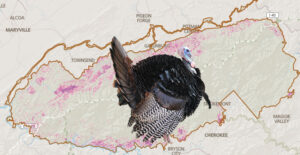Great Smoky Mountains National Park’s Inventory and Monitoring Branch has partnered with the Department of Electrical Engineering and Computer Science (EECS) and the School of Arts at the University of Tennessee (UT), Knoxville, to create a new web application called Species Mapper. Everyone from park managers to school groups can use Species Mapper to explore suitable habitats for over 1,800 plant and animal species. The application can be found at https://science.nature.nps.gov/parks/grsm/species.
Species Mapper uses locations where species have been found to help predict additional places where they may occur in the park. These predictions, or models, are based on observations made during ongoing resource monitoring as well as during research studies conducted by scientists from all over the world. The result of the model is a reliable distribution of where each species lives in the park.
 “This application allows park managers to use the vast amount of biological data collected over the past three decades to protect park resources and assess the potential impact from disturbances like hemlock woolly adelgid and emerald ash borer,” said Inventory and Monitoring Program Manager Tom Remaley. “Visitors can use this site to explore what lives in the park and what they might see during their visit.”
“This application allows park managers to use the vast amount of biological data collected over the past three decades to protect park resources and assess the potential impact from disturbances like hemlock woolly adelgid and emerald ash borer,” said Inventory and Monitoring Program Manager Tom Remaley. “Visitors can use this site to explore what lives in the park and what they might see during their visit.”
The model uses supercomputers managed by the UT/Oak Ridge National Laboratory’s Joint Institute for Computational Sciences to analyze the location of observations as well as the characteristics of the environment such as slope, forest type, geology, elevation, temperature, and sun exposure. Faculty and post-doctoral researchers from UT’s national Institute for Mathematical and Biological Synthesis have also contributed to the scientific analysis of the data and the models.
“This project is about plowing through large quantities of data and an immense computational space to bring scientific insights to the fore,” said Dr. Jian Huang, a full professor in the EECS department. “We are excited to continue the long-term partnership with the National Park Service to help students, teachers and managers alike to make effective use of big data in order to better connect people to the nature and preserve America’s special places.”
Park managers will continue to add observations to the application making it more reflective of all species found within the park and increasing the accuracy of the prediction model. Many of these observations will come from the All Taxa Biodiversity Inventory (ATBI), which is a park-wide biological inventory of all life forms. Over 19,000 species have now been recorded in the park, with nearly 1,000 of those species having never been seen anywhere in the world before being discovered and described in the Smokies. The ATBI in the Smokies is coordinated by the park’s non-profit partner, Discover Life in America (DLIA).
For more information about biological diversity in the park, visit the park website at https://www.nps.gov/grsm/learn/nature/index.htm and the Discover Life in America website at https://www.dlia.org.
– NPS



